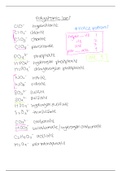Class notes
Chemotherapy and Drug Resistance
- Course
- Institution
*Conventional Cancer Treatment * Therapeutic Window *Conventional Therapies * Gleevec *Resistance *Phenomenon *P-Glycoprotein * Drug Metabolism *Glutathione S Transferase *Dihydrofolate Reductase (DHFR)
[Show more]









